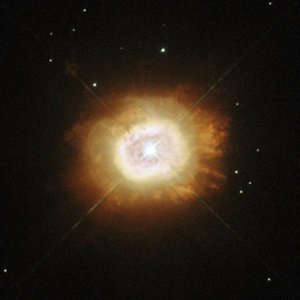Campbell's Hydrogen Star is an unusual object in the constellation of Cygnus.
Background information and spectra
aka: HD 184738, V1966 Cyg, PK 064+05.1, vv 235 ... and others

Credit:
ESA/Hubble & NASA
Acknowledgement: Jean-Christophe Lambry |
Discovered in 1893 by the American astronomer William Campbell who was observing through a visual spectroscope at Lick Observatory. He recognised from its spectrum that this strange object in southern Cygnus was clearly not an ordinary star,
The star itself is known as a [WC] star, a rare class resembling their much more massive counterparts — Wolf-Rayet stars. [WC] stars are rather different: they are low-mass Sun-like dwarf stars at the end of their lives. While these stars have recently ejected much of their original mass, the hot stellar core is still losing mass at a high rate, creating a hot wind. It is these winds that cause them to resemble Wolf-Rayet stars. [WC] stars are identified by the carbon and oxygen in their winds. Some true Wolf-Rayet stars are rich in nitrogen instead, but this is very rare among their low-mass counterparts.
Data from
ESA/Hubble site
Spectrum in planetary nebulae section is here |